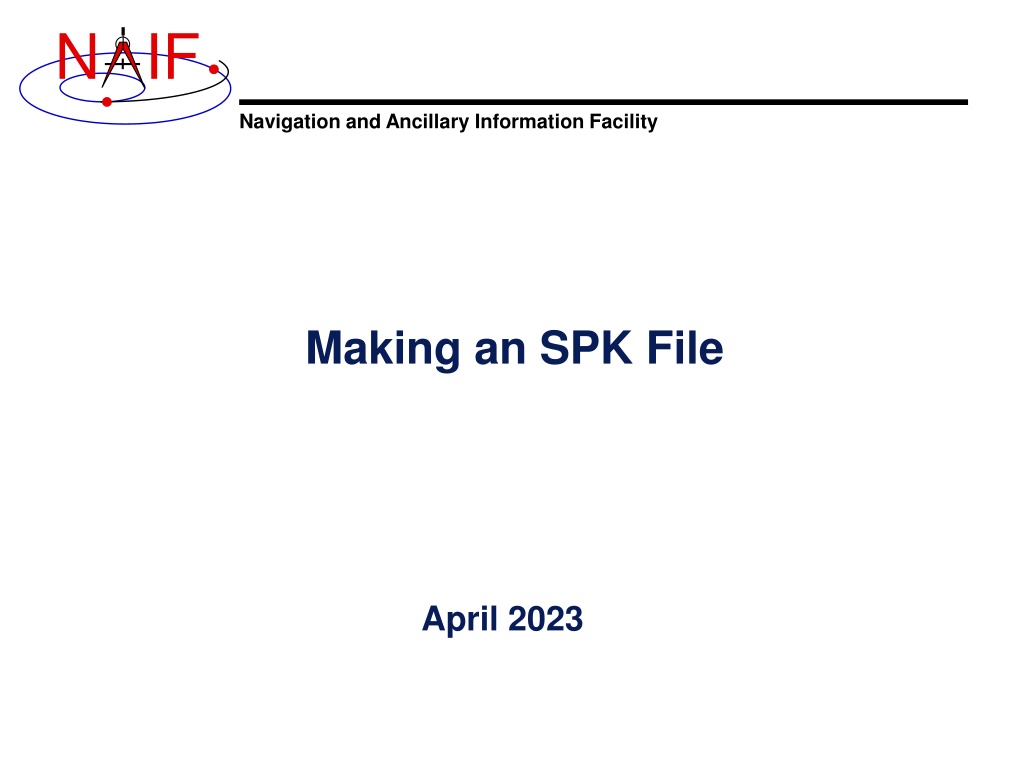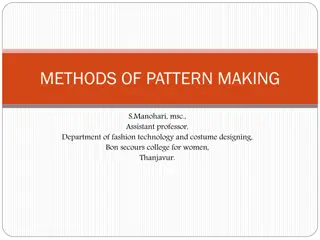
Making an SPK File for N.IF Navigation Facility
Explore the tutorial on creating SPK files for the N.IF Navigation and Ancillary Information Facility for April 2023. Learn about SPK production methods, recommended types, and the tools needed. Understand the purpose, scope, and assumptions for making SPK files efficiently.
Download Presentation

Please find below an Image/Link to download the presentation.
The content on the website is provided AS IS for your information and personal use only. It may not be sold, licensed, or shared on other websites without obtaining consent from the author. If you encounter any issues during the download, it is possible that the publisher has removed the file from their server.
You are allowed to download the files provided on this website for personal or commercial use, subject to the condition that they are used lawfully. All files are the property of their respective owners.
The content on the website is provided AS IS for your information and personal use only. It may not be sold, licensed, or shared on other websites without obtaining consent from the author.
E N D
Presentation Transcript
N IF Navigation and Ancillary Information Facility Making an SPK File April 2023
N IF Table of Contents Navigation and Ancillary Information Facility Purpose Scope Assumptions about user s knowledge SPK overview Summary of SPK architecture Discussion applicable to all production methods Recommended SPK types Selecting the polynomial degree (for polynomial SPK types) SPK production methods Using the Make SPK (MKSPK) program Using SPICELIB, CSPICE or IDL writer modules (APIs) Finishing up, applicable to all methods Adding comments Validation Merging Special requirements for making SPKs to be used in DSN/SPS software for view period generation, scheduling, metric predicts generation, and related functions. Issues affecting performance (reading efficiency) and usability Making an SPK File 2
N IF Purpose Navigation and Ancillary Information Facility This tutorial provides guidance for writing an SPK file using software provided by NAIF: the MKSPK application program or SPK writer modules from SPICELIB (FORTRAN), CSPICE (C- language), Icy (IDL) or Mice (MATLAB) toolkit Only partial implementation in Icy and Mice Making an SPK File 3
N IF Scope Navigation and Ancillary Information Facility This tutorial addresses production of SPKs: for general purposes for use with NASA s Deep Space Network (DSN) This tutorial does not address production of SPKs: by JPL navigation teams using MONTE and the NIOSPK utility by ESA/ESAC for its missions that use SPICE Those use custom MEX2KER software that was provided by NAIF having TCB time tags, in support of certain IAU needs These are SPK Types 101, 102, etc. use of the OEM2SPK utility, used to process CCSDS* Orbit Ephemeris Message files See the OEM2SPK User s Guide for this information *CCSDS = Consultative Committee for Space Data Systems Making an SPK File 4
N IF Background Assumptions Navigation and Ancillary Information Facility It is assumed the reader has some familiarity with the SPICE system, and with basic ideas of orbital mechanics. The SPICE Overview tutorial ( spice_overview ) is available at: https://naif.jpl.nasa.gov/pub/naif/toolkit_docs/Tutorials/pdf/individual_docs/ It is assumed the reader has read the SPK Tutorial that characterizes much of the SPK subsystem, with emphasis on reading SPK files. The SPK reading tutorial ( spk ) is available at: https://naif.jpl.nasa.gov/pub/naif/toolkit_docs/Tutorials/pdf/individual_docs/ It is assumed the reader has available the SPK reference document entitled SPK Required Reading, supplied with each copy of the SPICE Toolkit (.../doc/spk.req) SPK Required Reading is also available at: https://naif.jpl.nasa.gov/naif/documentation.html Making an SPK File 5
N IF SPK References Navigation and Ancillary Information Facility References for SPK production Making an SPK tutorial (this document) SPK (Ephemeris System) tutorial (focused on reading an SPK) SPK Required Reading technical reference (spk.req) MKSPK Users Guide (mkspk.ug) The source code headers provided as part of the SPK writer modules (subroutines) SPKMERGE User s Guide (spkmerge.ug) SPY User s Guide (spy.ug) Making an SPK File 6
N IF Brief Overview - 1 Navigation and Ancillary Information Facility You should understand the physics of your data and how that relates to SPK type. For instance: Type 5 works best for an orbit well approximated by a sequence of one or more conic orbits. Types 9 and 13 fit data regardless of the expected physics. Caution: a good fit in the mathematical realm may not respect the physics of the trajectory. For example, fitting polynomials to an excessively sparse set of states for a planetary orbiter could result in an interpolated path that intersects the planet. Making an SPK File 7
N IF Brief Overview - 2 Navigation and Ancillary Information Facility Ordinarily, use the NAIF MKSPK application to create SPKs from Cartesian state data or conic elements. Depending on your source data, SPK types 5, 9, 10, and 13 will satisfy the requirements for most users. Type 5, yields compact SPK files when the trajectory is well approximated by piecewise two-body motion. Type 5 may be the best choice for planetary or solar orbiters when available state data are sparse. Type 9, a good, general choice Type 13, when you have very accurate velocity data Type 10 applies ONLY to Two Line Element Sets (TLEs). Alternatively, use the Toolkit s SPK writing subroutines in your own production program. Caution: an SPK made for use by the NASA DSN has additional requirements, discussed later on. Making an SPK File 8
N IF Navigation and Ancillary Information Facility Summary of SPK Architecture Making an SPK File 9
N IF SPK File Structure: The User's View Navigation and Ancillary Information Facility Logical Organization of an SPK File Comment area Always present Segment 1 Possibly present - sometimes by your choice - sometimes required Segment n Making an SPK File 10
N IF SPK File Structure - 1 Navigation and Ancillary Information Facility A minimal SPK file, containing only one segment Records are fixed-length: 1024 bytes ID WORD ND NI IFNAME FWD BWD FREE BFF FTP 0 PAD File record: One record. 0 PAD Comment area: Present only if used. If used, one or more records. Comment area text U* Descriptor record: Contains 1 to 25 segment descriptors. One record. D1 U N/P/C Segment ID record: Contains 1 to 25 segment IDs. One record. U I1 Segment 1 Data segment: One or more records. ID WORD: Indicates file architecture and type N/P/C: Next, previous record pointers and descriptor count ND, NI: Number of d.p. and integer descriptor components Dn: Descriptor for segment n IFNAME: Internal file name In: Segment ID for segment n FWD, BWD: Forward and backward linked list pointers FREE: First free DAF address U: Unused space BFF: Binary file format ID U*: Possibly unused space FTP: FTP corruption test string Making an SPK File 11
N IF SPK File Structure - 2 Navigation and Ancillary Information Facility An SPK file containing multiple segments in this example, 27 Records are fixed-length: 1024 bytes ID WORD ND NI IFNAME FWD BWD FREE BFF FTP 0 PAD File record: One record 0 PAD Comment area: Present only if used. Comment area text U* Descriptor record: Contains 1 to 25 segment descriptors. One record. D1 D2 D25 N/P/C Segment ID record: Contains 1 to 25 segment IDs. One or more records. I2 I1 U I25 Segment 1 Segment 2 Data segments: One or more records per segment. (Up to 25 segments.) . . . . . . Segment 25 U* Descriptor record: Contains 1 to 25 segment descriptors. One record. U N/P/C D26 D27 U Segment ID record: Contains 1 to 25 segment IDs. One or more records. I26 I27 Segment 26 Data segments: One or more records per segment. (Up to 25 segments.) Segment 27 U* Making an SPK File 12 Diagram not to scale
N IF SPK File Structure - Description Navigation and Ancillary Information Facility File record Contents Internal file name (set by file creator) Architecture and binary file format identifiers File structure parameters FTP transmission corruption detection string Used by SPK reader and writer subroutines Comment Area A place where metadata (data about data) may be placed to help a user of the SPK file understand the circumstances of its production and any recommendations about for what uses it was intended Descriptor record and Segment ID record One of each of these is needed for every collection of 1-to-25 segments Segment[s] Collection[s] of ephemeris data Minimum of one segment Maximum: The practical maximum is a few thousand segments Serious performance degradation occurs above 100000 segments for a single body Absolute limits are imposed by the range of the INTEGER data type for your computer Numerous SPK types may be used within an SPK file, but only one SPK type may appear within a given segment Segments of different types may be intermixed within a given SPK file Making an SPK File 13
N IF What is an SPK Segment? Navigation and Ancillary Information Facility A segment is a collection of information: providing ephemeris (position and velocity) of a single object given relative to a single center of motion specified in a single reference frame known to SPICE Either built-in ( hard coded ) or defined in a loaded frames kernel (FK) covering a specified, continuous period of time, and using a single SPK data type Example: ephemeris for the Voyager 2 spacecraft, relative to the center of the Neptunian system (Neptune s barycenter), given in the J2000 inertial reference frame, covering a specific period of time, and using Hermite interpolation with variable length intervals, produced using SPK Type 13 An SPK segment must contain enough data to yield an object s state at any epoch within the time bounds associated with the segment This has implications that depend on the SPK type being produced Making an SPK File 14
N IF Navigation and Ancillary Information Facility Discussion applicable to all SPK production methods Making an SPK File 15
N IF The SPK Family Navigation and Ancillary Information Facility Type Description Notes 1 Modified divided difference arrays Unique form produced at JPL; not likely to be useful to others. 2 Chebyshev polynomials for position; fixed length time intervals. Velocity is obtained by differentiation. Used at JPL for planets. Evaluates quickly. 3 Chebyshev polynomials for position and velocity; fixed length time intervals Separate polynomial sets for position and velocity. Used at JPL for natural satellites. 4 Special form used only by Hubble Space Telescope Not available for general use. 5 Discrete states using weighted two-body propagation Ok if motion very closely approximates two-body motion. 6 Special form of trigonometric expansion of elements for Phobos and Deimos Not available for general use. 7 Precessing elements Not available for general use. 8 Lagrange interpolation of position and velocity; fixed length intervals between states Use Type 9 unless state spacing is truly uniform when measured in the TDB system. 9 Lagrange interpolation of position and velocity; variable length intervals between states Versatile type; easy to use with MKSPK. 10 Weighted two-line element sets (Space Command) Handles both near-earth and deep space versions. 11 Not used 12 Hermite interpolation of position and velocity; fixed length intervals between states Use Type 13 unless state spacing is truly uniform when measured in the TDB system. 13 Hermite interpolation of position and velocity; variable length intervals between states Versatile type; easy to use with MKSPK. Use for DSN support. 14 Chebyshev polynomials for position and velocity, variable length time intervals The most flexible of the Chebyshev types. 15 Precessing conic elements propagator --- 16 Not available for general use. Special form used by ESA s Infrared Space Observatory 17 Equinoctial elements Used for some satellites. 18 Used for SMART-1, MEX, VEX, and Rosetta Emulation of ESOC s DDID format 19 Similar to Type 18, but uses mini-segments to reduce the number of true segments needed. (New in N65 toolkits.) Revised emulation of ESOC s DDID format 20 Chebyshev polynomials for velocity; fixed length time intervals. Provided to handle ephemerides produced by the Institute of Applied Astronomy in St. Petersburg, Russia. (New in N65 toolkits.) Making an SPK File 21 Modified divided difference arrays Same as Type 1 except allows greater number of coefficients. 16
N IF Recommended SPK Data Types - 1 Navigation and Ancillary Information Facility SPK type 2 (Chebyshev polynomials for position, velocity given by differentiation) Used at JPL for planetary ephemerides. SPK type 3 (Separate Chebyshev polynomials for position and velocity) Used at JPL for satellite ephemerides. SPK type 5 (Weighted two-body extrapolation) Often used for comets and asteroids, as well as for sparse data sets where a two-body approximation is acceptable. SPK types 9 and 13 (Sliding-window Lagrange and Hermite interpolation of unequally-spaced states) Often used by users of NAIF s Make SPK (MKSPK) application. SPK type 10 (weighted Space Command two-line element extrapolation) Often used for earth orbiters. SPK type 14 (Separate Chebyshev polynomials for position and velocity, with variable time steps) This is the most flexible Chebyshev data type. SPK type 15 (Precessing conic elements) Provides a very compact ephemeris representation; limited to orbits where this type of approximation is valid. SPK type 17 (Equinoctial elements) Most suited for representation of ephemerides of natural satellites in equatorial or near-equatorial orbits. Making an SPK File 17
N IF Recommended SPK Data Types - 2 Navigation and Ancillary Information Facility Each type has certain properties that may promote or limit its usefulness in a particular application. These properties include but are not limited to the following. Ability to model the actual ephemeris to be represented with the accuracy required for your application. Consistency between velocity and derivative of position. Evaluation speed (performance). Compactness (file size). Availability of SPICE software needed to write files of that type. Users are encouraged to consult with NAIF about the suitability of an SPK type for a particular purpose. Making an SPK File 18
N IF Creating Multiple SPK Segments Navigation and Ancillary Information Facility Each SPK segment must have a single object, center of motion, reference frame and SPK data type. Limiting segment size to 10,000 states or packets of ephemeris data can improve performance when searching within a segment. Absolute limits on segment size depend on the size of the INTEGER data type. The total number of segments for any one body in a single SPK file must be kept under the dimension of the SPKBSR segment buffer, currently set to 100,000. The total number of segments for any one body, contributed by all loaded SPK files, must be kept under the 100K limit. For best efficiency, the total number of concurrently loaded segments for all bodies should be less than this 100K limit. Adherence to this criterion ensures that loaded SPK files need not be searched repeatedly for segment descriptors (which contain summary data). More details about reading efficiency are provided at the end of this tutorial. One may elect to initiate a new segment (or more) as the means for modeling a propulsive maneuver. This is because the SPK reader modules will NOT allow interpolation over a segment boundary. When starting a new segment you may use a new segment identifier, for instance to indicate a new trajectory leg after a maneuver. Can only be done if using SPK writer modules not if using the MKSPK application. Making an SPK File 19
N IF Choosing Polynomial Degree Navigation and Ancillary Information Facility If you make a Type 8 or 9 (Lagrange interpolation) or a Type 12 or 13 (Hermite interpolation) SPK file you must specify the degree of the interpolating polynomial that the SPK reader subroutine will use. This choice needs some consideration about desired accuracy, file size and evaluation speed (performance). This choice is also affected by the smoothness of the orbit data you wish to represent with an SPK file. The allowed range of degree is 1-to-27. In addition, to ensure position and velocity continuity over the time span covered by the orbit data: for Types 8 and 9, the polynomial degree must be odd. for Types 12 and 13, the polynomial degree must be equivalent to 3-mod-4, meaning degree 3, 7, 11, 15, 19, 23 or 27. Making an SPK File 20
N IF Reference Frame Navigation and Ancillary Information Facility Any reference frame known to the SPICE system, whether built-in (hard coded) or defined at run time through a Frames Kernel (FK), may be used for ephemeris data placed in an SPK file. If the frame is provided via an FK, that same FK must be used when reading the SPK Some examples of typical reference frames used: Inertial (non-rotating): J2000: Earth Mean Equator and Equinox of J2000, a.k.a. EME2000; J2000 is generally used in SPICE as a label for the ICRF frame ECLIPJ2000: Mean ecliptic and equinox of J2000 Body-fixed (non-inertial) ITRF93: International Terrestrial Reference Frame, for earth MOON_PA: Moon Principal Axes Making an SPK File 21
N IF Navigation and Ancillary Information Facility SPK Production Methods
N IF Choices for Making an SPK File Navigation and Ancillary Information Facility There are two* methods available for making an SPK file. 1. Take an ephemeris data file produced by your own trajectory propagator program and input this into the conversion utility (MKSPK) provided by NAIF that outputs an SPK file. 2. Incorporate the appropriate SPK writer modules (subroutines) into your own code: Add these routines to your trajectory estimator/propagator. or... Write your own post-processor conversion utility, similar to MKSPK mentioned above. Both methods are described in the next few pages. *The OEM2SPK and NIOSPK specialized utilities are also methods, but are not discussed in this tutorial. Making an SPK File 23
N IF Making Your Choice - 1 Navigation and Ancillary Information Facility Using the MKSPK program provided in the Toolkit could be the easiest and safest for many situations. Provides considerable flexibility for accepting a wide assortment of input data formats. Allows one to make multi-segment SPK files when the target, center of motion, reference frame, or SPK type changes. But not as straight forward as it could/should be. Best done through multiple program executions (although one could be tricky and accomplish this in a single execution). A future version of MKSPK may better accommodate this. Note: production of multiple segments in type 5, 8, 9, 12 and 13 SPK files, when the amount of input data requires this, is automatically handled. Making an SPK File 24
N IF Making Your Choice - 2 Navigation and Ancillary Information Facility Using the SPK writer modules found in SPICELIB, CSPICE, Icy and Mice offers the greatest flexibility and user control. Using these requires that you write your own program. You ll likely need to use some additional SPICE modules as well. Making an SPK File 25
N IF Navigation and Ancillary Information Facility Using NAIF s MKSPK Application Program Making an SPK File 26
N IF Using the MKSPK Utility - 1 Navigation and Ancillary Information Facility Setup file NAIF s MKSPK Program ASCII file of ephemeris data SPK File Optional comment file Possible SPK data types produced are: Suitable kinds of input ephemeris data are: - Table of Cartesian state vectors - Table of conic elements - One or more sets of equinoctial elements - One or more sets of Space Command two- line elements - Type 05 - Type 08 - Type 09 - Type 10 - Type 12 - Type 13 - Type 15 - Type 17 Making an SPK File 27
N IF Using the MKSPK Utility - 2 Navigation and Ancillary Information Facility This table indicates which SPK types can be made from the four kinds of input data accepted by MKSPK SPK Type Produced by MKSPK --> Input Data Type Cartesian state vectors Conic elements Equinoctial elements Space Command Two-line elements 5 8 9 10 12 13 15 17 Y Y N N Y Y N N Y Y N N N N N Y Y Y N N Y Y N N Y Y N N Y Y Y N Y = Yes N = No Making an SPK File 28
N IF Using the MKSPK Utility - 3 Navigation and Ancillary Information Facility MKSPK will produce a file consisting of one or more segments as needed. It can write up to 10,000 data points in one segment. For multi-segment files based on types 5, 8, 9, 12 and 13, the program will repeat sufficient data points at both sides of each interior segment boundary to ensure the SPK file will provide a continuous ephemeris through the segment boundary epoch. You can use MKSPK to add a new segment to an existing SPK file. You can use SPKMERGE to merge two or more SPK files made from separate executions of MKSPK. It s important to fully understand how SPKMERGE works if you do this; see the User s Guide. Making an SPK File 29
N IF Using the MKSPK Utility - 4 Navigation and Ancillary Information Facility MKSPK does not provide direct/specific means for including propulsive maneuvers within an SPK file. Instead, use either of these two methods. Append a new SPK segment to an existing SPK file, using MKSPK. Merge a collection of SPK files, using SPKMERGE. Making an SPK File 30
N IF Navigation and Ancillary Information Facility Using SPK Writer Modules Making an SPK File 31
N IF Using SPK Writer Routines Navigation and Ancillary Information Facility The next several charts outline how to use the SPK writer modules available in the Toolkit libraries. The types available in the supported Toolkits are summarized below.* SPK Types Supported 1 2 3 4 5 6 7 8 9 10 11 12 13 14 15 16 17 18 19 20 21 SPICELIB (Fortran 77) CSPICE (C) ICY (IDL) MICE (MATLAB) = 4, 6, 7, 16: made for special circumstances; not available for general use = 11: ID was not used * As of Toolkit version N67 Making an SPK File 32
N IF What Routines To Use - 1 Navigation and Ancillary Information Facility For all except SPK type 14 SPKOPN SPKOPA to append to existing file.) SPKWxx Write a segment of SPK type xx . . [SPKWxx] [ Write more segments ] . [ Repeat as needed ] . SPKCLS Close the file Open a new SPK file. (Use [ ] indicates possible multiple occurrences These routine names are for the FORTRAN (SPICELIB) Toolkit. For CSPICE the names are the same but are in lower case and have an _c appended. For Icy and Mice, module names are case-insensitive and have "cspice_" prepended. Making an SPK File 33
N IF What Routines To Use - 2 Navigation and Ancillary Information Facility For SPK type 14 SPKOPN, SPKOPA SPK14B SPK14A [SPK14A] SPK14E SPK14B SPK14A [SPK14A] SPK14E etc. SPKCLS Open file to add data Begin a new segment Add data to segment Add more data End the segment Begin a new segment Add data to segment Add more data End the segment Repeat as needed Close the file [SPK14A] indicates possible multiple occurrences Making an SPK File 34
N IF Close the SPK File Navigation and Ancillary Information Facility Once you have completed the addition of all data to your SPK file, be sure to call the SPKCLS routine to close the file. Failure to properly close an SPK file will result in a problem file having been produced. This point is emphasized here because it has been a frequent problem. Making an SPK File 35
N IF Navigation and Ancillary Information Facility Finishing Up Making an SPK File 36
N IF Not Quite Done Yet Navigation and Ancillary Information Facility You ve now used either MKSPK or the appropriate SPK writer routines to produce an SPK file. To complete the job you should do the following. Add comments (metadata) to the comment area of the SPK file. This could have been done during execution of MKSPK. It can be done after the SPK has been created by using the Toolkit s commnt utility program. Validate the file before sending it off to your customer. Consider if there is a need to merge this newly made SPK file with others. See the next several charts for more information on these subjects. Making an SPK File 37
N IF Add Comments (metadata) Navigation and Ancillary Information Facility It is strongly recommended that the producer of an SPK file add to the file, in the comment area, appropriate descriptive information. Topics should include at least: when, how and by whom the file was created, intended use for the file, cautions or restrictions on how the file is to be used. The comments might also include some of these topics. Time coverage Ephemeris objects included Type(s) of data used (in the sense of reconstructed versus predicted) Any available estimates of accuracy Sources of the data used to produce this SPK file Name(s) of previously generated SPK file(s) being replaced by this file Any knowledge of plans for future updates to (replacements for) this file Name and version number of your SPK production program Type of platform (hardware/OS/compiler) on which the SPK file was generated If you are modifying an existing SPK file, be sure to check the existing comments to see if updates are needed in addition to adding appropriate new ones. Making an SPK File 38
N IF How to Add Comments to an SPK Navigation and Ancillary Information Facility Several means are available for adding comments (metadata) to an SPK file. An option in the MKSPK program allows comments supplied in a separate text file to be added to the comment area during MKSPK execution. Use the COMMNT utility program from the SPICE Toolkit. This may be run as an interactive program or in command line mode within a script. If using FORTRAN, C or IDL you can use APIs. Not currently supported in MATLAB. Making an SPK File 39
N IF Validate the SPK File Navigation and Ancillary Information Facility Validation of SPK files is critical Caution is needed more for one-of-a-kind files than for those generated in a previously tested, unchanging process. Some SPICE utility programs might help with your validation. SPY: can do a variety of structure and semantic checks. SPY is available from the Utilities link of the NAIF website. SPKDIFF: used to statistically compare two supposedly similar SPK files. SPKDIFF is available in each Toolkit package and also from the Utilities link of the NAIF website. Consider writing your own validation program. Caution: successfully running an SPK summary program (e.g. BRIEF or SPACIT) or successfully running the format conversion program (TOXFR or SPACIT) is a positive sign, but is not a sufficient test. Making an SPK File 40
N IF Validate the Overall Process Navigation and Ancillary Information Facility When you first start producing SPK files, or when changing the SPK type used or the kind of mission (trajectory) to be represented, validation (or revalidation) of the overall process is advised. Validation of not only SPKs, but of end products derived from SPKs, is advised. Consider writing a program that compares states from your source data with states extracted from your new SPK file. Do this using interpolated states from your source data not just the states placed in the SPK file. Verify a uniformly good fit over the whole time interval covered by the file. Making an SPK File 41
N IF Common SPK Production Errors Navigation and Ancillary Information Facility Some of the most common SPK production errors are these Picking an SPK type that can not well represent the ephemeris data you wish to represent For Types 8, 9, 12 and 13, picking an invalid polynomial degree For Types 8, 9, 12 and 13, picking a polynomial degree that does not allow high fidelity representation of your source ephemeris For Types 8, 9, 12 and 13, having a HUGE change in time step size in two time-adjacent SPK segments For Types 8, 9, 12 and 13, allowing position and/or velocity data to have unduly large discontinuities at segment boundaries Leaving time gaps between segments (even very small, sub- second gaps can cause problems for users) It takes careful design to avoid, and careful validation to detect some of these! Making an SPK File 42
N IF Make a Merged SPK File ? Navigation and Ancillary Information Facility Sometimes it is helpful to customers if portions of two or more SPK files are merged into just one. (Sometimes the opposite is true, so be careful!) If making a merged product is appropriate, use the SPICE utility SPKMERGE. Read the SPKMERGE User s Guide. Be especially aware of how SPKMERGE directives affect the precedence order of the data being merged. (This is different from the precedence order that applies when one reads an SPK file or files.) Carefully examine your results (probably using either BRIEF or SPACIT) to help verify you got what you expected. If you ve made a merged SPK file, check to see that the included comments are appropriate. Making an SPK File 43
N IF Get Help Navigation and Ancillary Information Facility Considering consulting with JPL s NAIF team for assistance with: picking the SPK type to be used picking the method for producing SPK files designing tests to validate the process Examine SPK files from other missions that could help you check your process. Such files can be found under the "Data" link on the NAIF website. Making an SPK File 44
N IF Navigation and Ancillary Information Facility Backup Making SPKs for use by the DSN SPK reading efficiency Making an SPK File 45
N IF DSN Interface Overview Navigation and Ancillary Information Facility SPKs prepared for use in the DSN/SPS may be used in one or more of four DSN software sets: Metric Predicts Generator (MPG) Used for view period generation, DSN scheduling and DSN metric predicts (antenna pointing and tuning of the transmitters and receivers) Telecomm Predicts (UTP/TFP) Subsystem for prediction and analysis of telecommunications signal levels Radiometric Modeling and Calibration Subsystem (RMC) Used to calibrate atmospheric effects on radio waves Delta Differenced One-way Range (Delta-DOR) subsystem A special tracking data type providing additional precision to spacecraft navigation All SPKs delivered to the SPS must pass through a front- end gateway that has some restrictions that go beyond SPICE requirements; see the next page. Making an SPK File 46
N IF SPS Validation Gateway Navigation and Ancillary Information Facility The SPS front-end gateway requires: an SPK contain data for only one spacecraft The presence of non-spacecraft ephemeris data is ok an SPK have no data gaps for the spacecraft Additionally, for historical reasons, the spacecraft SPK must be of Type 1 or Type 13 This restriction could be diminished or removed sometime in the future if DSN personnel find time to test the Metric Predicts Generator code using additional SPK data types. Making an SPK File 47
N IF SPK Reading: Efficiency Issues - 1 Navigation and Ancillary Information Facility SPK file creators should design files to support efficient read access by those who will use the SPKs. This requires knowledge of how SPK file attributes impact efficiency. When you store "large" amounts (>10^7 states or data packets) of ephemeris data in one or more SPK files, SPK reading efficiency may be affected by: SPK segment size the number of segments for a body in one SPK file the number of segments for a body contributed by multiple SPK files the number of loaded segments for all bodies the number of loaded files Making an SPK File 48
N IF SPK Reading: Efficiency Issues - 2 Navigation and Ancillary Information Facility Segment size When a segment contains more than 10,000 states or data packets, the SPK readers will generally take longer to search the segment for requested data. When the segment is larger than this size, more records are read to look up segment directory information. If these records are not buffered, more physical records are read from the SPK file. There is a trade-off between segment size and numbers of segments and files. It can be preferable to have large segments rather than have "too many" segments or files. (Read on) Making an SPK File 49
N IF SPK Reading: Efficiency Issues - 3 Navigation and Ancillary Information Facility Number of segments for a body in one SPK file An SPK file MUST not contain more segments for one body than can be "buffered" at one time. The SPK reading system buffers coverage descriptions ("segment descriptors") for segments it has examined to satisfy previous requests for state data. Don't confuse descriptor buffering with data buffering. The SPK reading system also buffers segment DATA, as opposed to segment descriptors, but this is not relevant to this discussion. One fixed-size buffer is used for all SPK segment descriptors. The size of this buffer is given by the parameter "STSIZE," declared in the SPKBSR suite of routines. STSIZE is currently set by NAIF to 100,000. NAIF recommends that users NOT change this parameter since maintenance problems may result. Unsurprisingly, the system works best when all needed segment descriptors are buffered simultaneously. continued on next page Making an SPK File 50






















